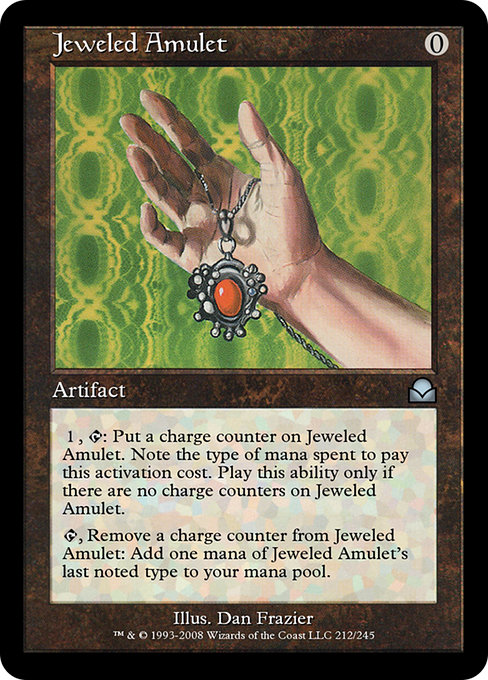
Image courtesy of Scryfall.com
Shifting Perspectives: Mana, Memory, and the Fan’s Eye Across Eras
Few MTG artifacts have sparked as much playful debate among fans as Jeweled Amulet. A 0-mana artifact from Masters Edition II, released in 2008, it sits at a delightful intersection of design ambition and fan interpretation 🧙🔥💎. Its text invites a kind of meta-game about color identity and the psychology of mana: the card itself remembers the color you paid with to fuel its activation, then later spits out one mana of that remembered color. For players and hobbyists who love both theorycraft and story, that memory mechanic becomes a storytelling device as much as a tabletop trick.
Jeweled Amulet is an artifact, not a creature, with a deceptively simple two-part workflow. First, you pay {1}, tap the tool, and put a charge counter on it while noting the type of mana you spent. The catch: you can activate this only when there are no charge counters on the amulet. Then you can tap the artifact and remove a charge counter, adding one mana of the amulet’s last noted color. The elegance lies in its restraint: a tiny, colorless object that can become a color-drenched catalyst—depending on your memory and timing 🧙🔥.
From a gameplay perspective, Jeweled Amulet underscores a key theme in MTG’s long arc: artifacts that bend the rules of color pie through memory and timing. Its mana production is not fixed to a single color or a specific color pair; instead, it reflects the last payment color, which can be anything from B (black) to W (white), U (blue), G (green), or R (red). This makes it a curiosity for five-color strategies and for players who relish “color fixation” puzzles in formats like Modern and Legacy, where color options can swing a game’s tempo. It’s a quiet reminder that a card’s power can be less about raw numbers and more about how players interpret and deploy its memory in the heat of a duel ⚔️🎲.
Fans have shaped its interpretation across eras with a blend of nostalgia, theory, and humor. In the early, more streamlined days of MTG’s design, players chased fixed mana sources and straightforward ramp. A zero-cost artifact that demands you remember the last paid color became a playful reminder that color identity can be a mental construct as well as a mechanical one. As formats evolved, the five-color landscape, plus modern commander play, gave Jeweled Amulet fresh life as a “color-pie memory keeper”—a talisman you can wield to reflect your deck’s emotional center as much as its mana curve 🧙🔥.
Dan Frazier’s art—the classic Masters-era aesthetic—adds to the fan experience. The image feels like a relic of a card-collection era when the glaze of the frame and the gem-like iconography suggested that treasure could be found in the smallest objects. The card’s rarity—uncommon—paired with its reprint history in Masters Edition II adds a layer of collector psychology: a cherished piece that blends old-school reverence with a modern appreciation for clever card design. The community’s discourse around it often touches on how memory-based effects can be more flavorful than brute force, especially when paired with the right deck archetypes in casual play 🧭🎨.
Beyond the table, Jeweled Amulet serves as a useful lens into how fans interpret design intent and lore. There isn’t a canonical narrative attached to every collectible artifact in MTG, but players spin stories about what the amulet remembers—the moment you cast a spell, the color you choose to channel, the memory that becomes mana. This has made Jeweled Amulet a popular talking point in conversations about how color identity can be both a mechanic and a theme, and how designers doubtless delight in creating triggers that reward careful reading, memory, and timing. That blend of rules-as-written and rules-as-understood is at the heart of MTG’s enduring charm 🧙🔥.
For fans who enjoy scanning set histories, Jeweled Amulet stands out as a microcosm of Masters Edition II’s ethos: a distilled, polished concept that invites experimentation. Its ability to convert the last noted color into mana makes it an elegant bridge between colorless control and color-fixed strategies. The card’s flipping potential—from “zero-cost setup” to “one-mana generation” based on memory—echoes a broader design philosophy: give players micro-choices that accumulate into meaningful, sometimes surprising outcomes. In that sense, the amulet is a small artifact with big storytelling potential, a gem that encourages both strategic depth and playful interpretation 🧭💎.
For modern readers and collectors alike, the card also serves as a reminder of how MTG’s history continues to resonate in new ways. The community’s ongoing discussions about reprints, rarity, and online heritage keep ancient cards aligned with contemporary decks and formats. Whether you’re a devoted EDH enthusiast who enjoys color-mixing puzzles or a casual player who loves old-school art and lore, the amulet offers a little something for everyone—an invite to slow down, appreciate the memory behind each color, and maybe beam a knowing smile at the turn your deck-making brain can take 🧙🔥.
As you tilt a plan around aJI—just-in-time insight—remember that Jeweled Amulet isn’t a flashy finisher; it’s a thoughtful prompt. It asks: what color memory will you pull from your latest activation? What story will your own mana memory tell as you roll into the midgame? The possibilities are as rainbow-shifting as MTG’s color pie itself, and that’s part of the magic that fans have celebrated for decades 🎨⚔️.
Neon Gaming Mouse Pad Non-Slip 9.5x8in Anti-Fray
More from our network
- https://transparent-paper.shop/blog/post/typography-overlays-for-social-media-design-tips-that-pop/
- https://blog.digital-vault.xyz/blog/post/create-cohesive-aesthetic-wallpaper-packs-for-mobile-devices/
- https://transparent-paper.shop/blog/post/ancient-light-and-low-metallicity-clues-in-a-blue-giant/
- https://blog.digital-vault.xyz/blog/post/crafting-landing-pages-that-turn-visitors-into-customers/
- https://crypto-acolytes.xyz/blog/post/understanding-daos-in-web3-governance-participation-and-power/